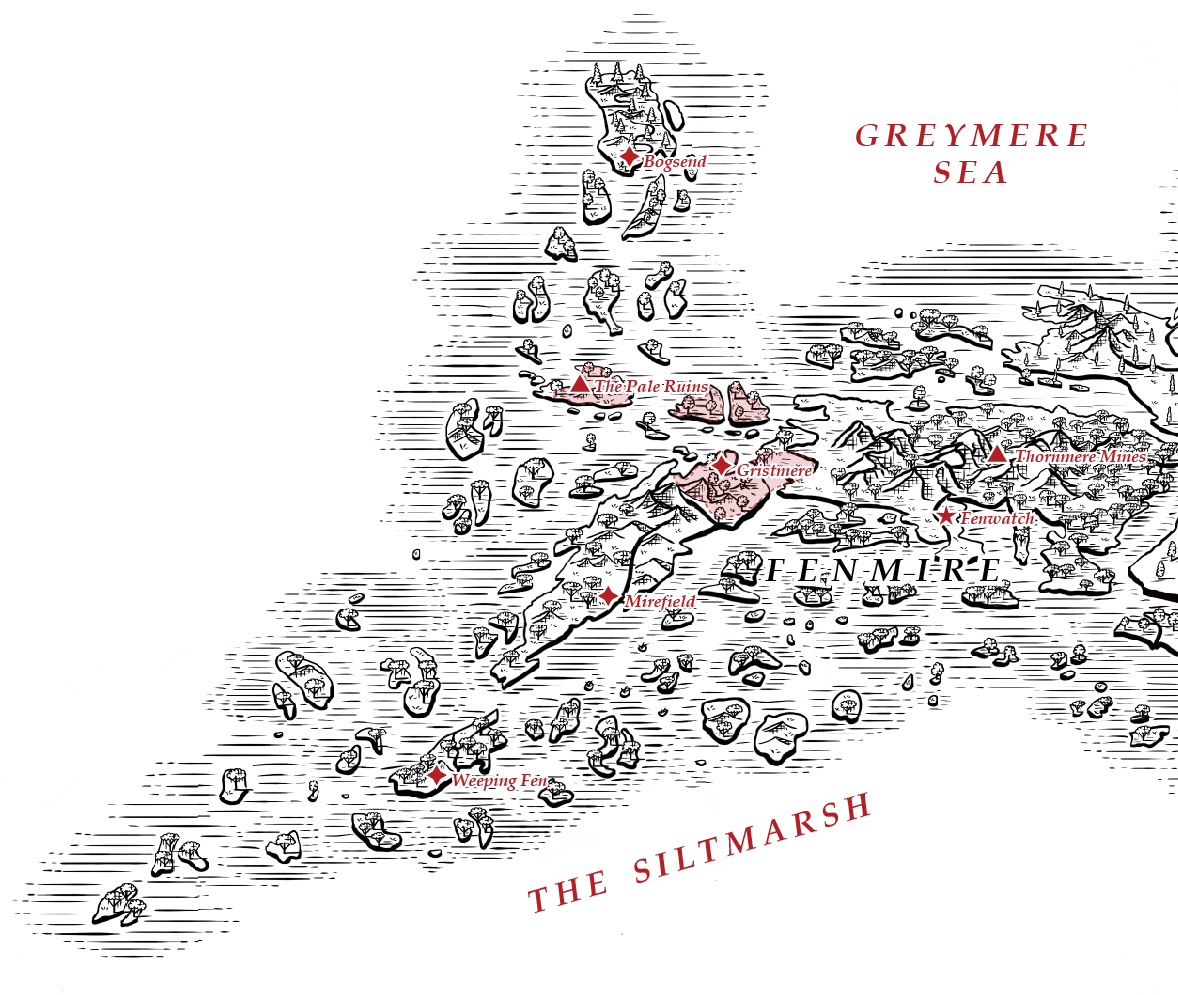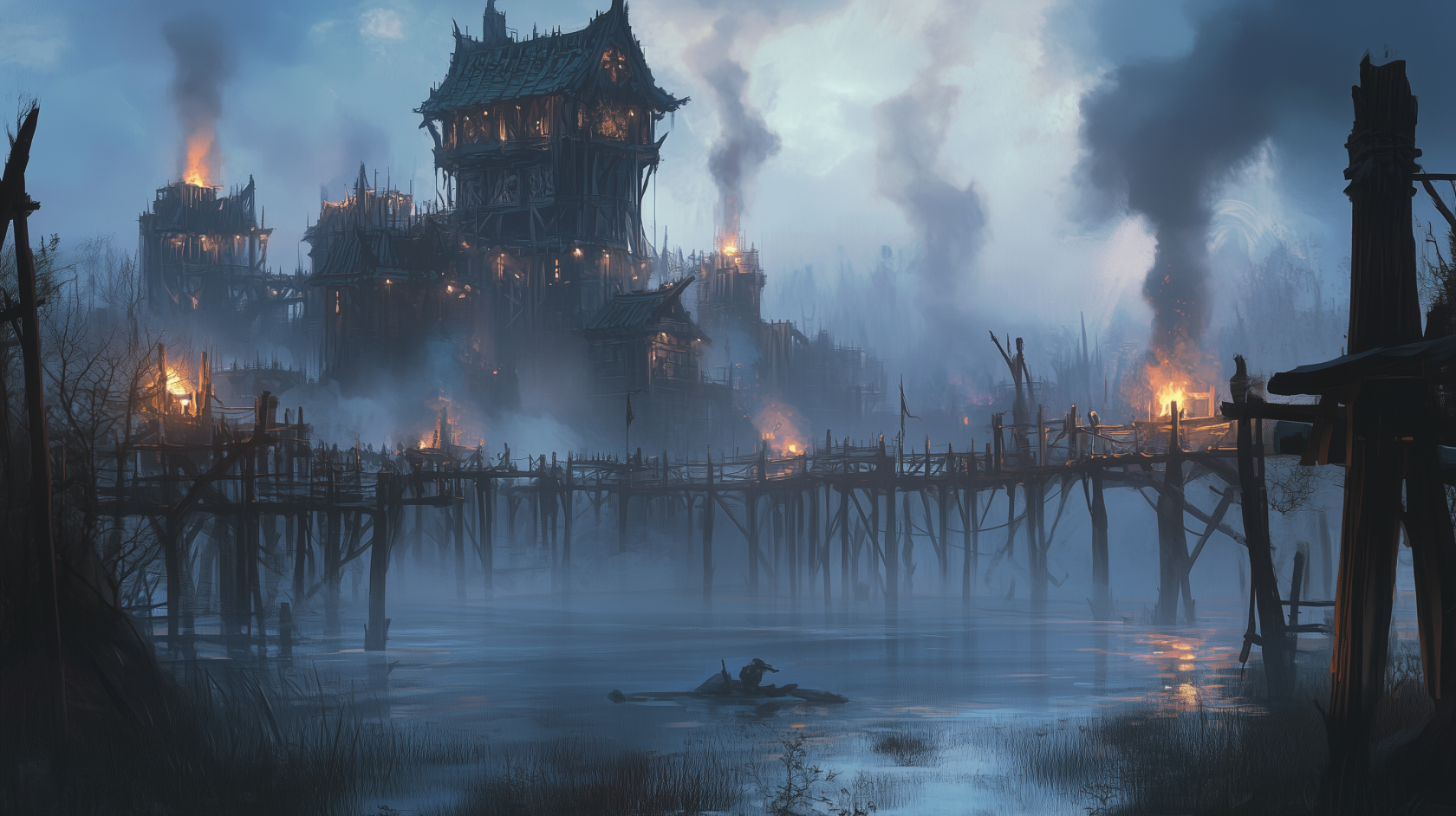Fenwatch
By Mire and Might.
Fenwatch is no jewel, no grand city of polished stone and gold. It is wood and iron, grit and toil, built by those who endure, not those who dream. The swamp rises to claim it, the Blight knocks at its gates, but we remain. We do not bow, we do not flee—Fenwatch stands because we have made it so.
— Lord Garric Harrowden
Fenwatch, the capital of Fenmire, began as little more than a trading post—a foothold carved from the swamp where merchants, trappers, and fortune-seekers could rest before delving deeper into the marsh. Positioned at the confluence of several navigable waterways, it became the ideal basecamp for those looking to exploit the riches of the fens. The original settlers were not noble pioneers but opportunists, drawn by the promise of wealth and the ease of taking advantage of the more primitive locals who had long called the marsh home. What started as a loose collection of shacks and market stalls soon grew into something more permanent.
As trade flourished, Fenwatch transformed into an established settlement, its rough-hewn buildings giving way to sturdier wooden structures built upon raised platforms to combat the ever-present floodwaters. Buildings are reinforced with thick pilings driven deep into the swampy earth, using a mixture of treated timber and stone salvaged from long-forgotten ruins to provide stability. The streets are little more than interconnected boardwalks and rope bridges, winding above the murky waters below. Some wealthier merchants and officials have invested in stone foundations, raising their homes above the marsh on fortified stilts, while others make use of intricate drainage systems and flood barriers fashioned from reclaimed iron and heavy wooden beams. The town’s defenses are makeshift but effective—watchtowers made of ironwood overlook the water routes, while palisades and spiked barricades form a rudimentary perimeter against both the dangers of the wild and the ambitions of rival factions.
House Harrowden came into control of Fenwatch not through conquest, but through necessity. In its early days, Fenwatch was little more than a lawless frontier town, ruled by competing factions of smugglers, mercenaries, and self-proclaimed merchant lords. When House Harrowden, a minor noble house at the time, established itself in Fenmire, it sought to bring order to the chaos—not out of benevolence, but out of a desire to claim the wealth flowing through the settlement. Using a combination of brute force, strategic alliances, and control over vital supply chains, they gradually outmaneuvered their rivals and declared themselves the region’s rightful rulers. Their authority was tenuous at first, but their discovery of the silver mines in Thornmere changed everything.
The discovery of silver beneath the fens transformed Fenwatch from a lawless backwater into a capital of consequence. The influx of wealth allowed House Harrowden to fortify its hold, hiring mercenaries to crush resistance and investing in infrastructure to make Fenwatch more than a ramshackle outpost. Harrowden, despite his brutish reputation, has always longed for the respect of the Baron and the noble houses of Faulmoor. He has poured resources into refining Fenwatch, constructing a central stronghold on higher ground where the swamp gives way to firmer land. This fortress, known as Harrow’s Rest, is built from imported stone and iron, a stark contrast to the decaying wood of the lower town. It serves as both a symbol of Harrowden’s power and a desperate plea for legitimacy in the eyes of his noble peers.
The arrival of the Rotmire Blight struck fear into the heart of Fenwatch, forcing the town to take drastic measures to survive. Unlike other settlements that were sealed behind stone walls, Fenwatch had no choice but to adapt its defenses against both the infected and the unforgiving marsh. Those suspected of carrying the Blight are swiftly exiled, cast into the swamp or sent adrift on makeshift rafts with no hope of return. House Harrowden has imposed strict quarantines, using hired enforcers and mercenaries to patrol the streets and enforce martial law. Infected bodies are burned on great pyres along the riverbanks, their smoke thick and acrid, a warning to all who enter.
Trade has been tightly controlled, with merchants forced to undergo rigorous inspections before being allowed to enter the city. Many attempt to bribe their way through, leading to a rise in corruption and underground smuggling. The price of silver has soared, as desperate nobles and warriors seek weapons to defend themselves from the horrors of the Blight. Some whisper that House Harrowden hoards the best supplies for itself, ensuring its own survival while the common folk are left to fend for scraps.
Fenwatch exists in a state of constant tension. It is a place of opportunity and lawlessness, where merchants and smugglers conduct business in equal measure, and where silver from the Thornmere Mines flows through shadowy hands before making its way to the rest of Faulmoor. The nobility’s grip is weak, with power shifting between ruthless merchant lords, hardened mercenaries, and those willing to do whatever it takes to survive. House Harrowden claims dominion over the town, but its rule is enforced by a patchwork of local enforcers, hired blades, and those who see value in maintaining the illusion of order.
Despite its dangers, Fenwatch remains the heart of Fenmire, the only semblance of civilization in a land that resists it at every turn. It is a place where fortunes are made and lives are lost with equal swiftness, where the scent of damp wood and river rot lingers in the air, and where the distant glow of swamp lanterns flicker like ghosts in the mist. Those who come to Fenwatch seeking wealth may find it, but the mire does not give without taking something in return.
Detailed Overview
| Attribute | Details |
|---|---|
| Region | Fenmire |
| Ruling House | House Harrowden |
| Population (Before Blight) | ~2,500 (A growing marshland town and trade hub) |
| Population (After Blight) | ~1,400 (Decline due to disease, forced conscription, and loss of workers to the mines) |
| Major Industries | Silver mining, fishing, smuggling, and black market trade |
| Primary Exports | Silver (from Thornmere Mines), preserved fish, marshland herbs and alchemical ingredients |
| Current Ruler | Lord Harrowden |
| Government Type | Feudal rule, dominated by House Harrowden, with local enforcers keeping order through intimidation and force |
| Defenses | Wooden palisade reinforced with scavenged stone, watchtowers overlooking the marsh, and a fortified bridge leading to Thornmere Mines |
| Notable Features | Thornmere Mines (rich in silver but nearly exhausted), Harrow’s Rest (Lord Harrowden’s fortified estate), The Sunken Stoat (infamous marsh tavern and smuggler haunt) |
| Status | Struggling but still holding, with increasing reliance on the mines, rising tensions over silver control, and growing fear of an approaching Blight outbreak |
Notable Establishments
The Sunken Stoat
A decrepit but lively tavern built atop half-collapsed docks, it serves as a meeting place for smugglers, mercenaries, and desperate travelers looking for work or passage deeper into the fens. Run by a one-eyed former pirate named Gideon Blacktide, it is known for its questionable ale and even more questionable clientele.
Harrow’s Rest
The fortified keep of House Harrowden, constructed of imported stone and iron, looming over the town as both a seat of power and a reminder of Harrowden’s aspirations. It is heavily guarded and only those with business or favor are permitted entry.
The Drowned Market
A floating bazaar where traders peddle goods salvaged from the swamp, from rare herbs to rusted relics of the past. Here, one can find everything from alchemical reagents to forbidden artifacts, though prices—and risks—are high.


